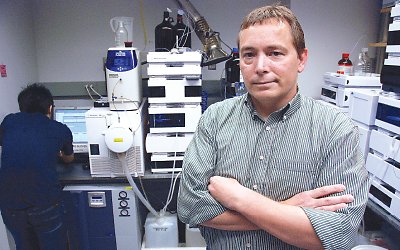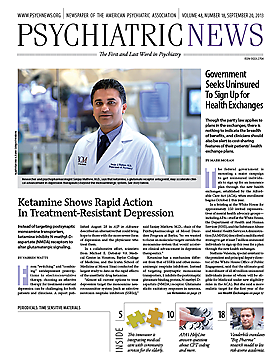Medicinal chemist Craig Lindsley, Ph.D., worked at several pharmaceutical companies before leaving for academia in 2006, the better to pursue discovery of new psychiatric drugs.
In academia, following the science is less risky, said Lindsley, who now holds the William K. Warren Jr. Chair in Medicine and is a professor of pharmacology and chemistry and director of medicinal chemistry and codirector (with Jeffery Conn, Ph.D.) of the Vanderbilt Center for Neuroscience Drug Discovery.
“At Vanderbilt, we can go very, very deep into the basic science, which helps you be more successful in drug discovery, because you have so much more knowledge about the target, the ligands, and so on,” he said in a recent interview in his office in Nashville.
The path through the warren of potential compounds starts with high-throughput screening, using robotics and sophisticated software to rapidly test hundreds or thousands of compounds against likely targets. Promising “hits” pass though cell-based functional assays, and then a select few molecules are tested in animals.
In fact, the Vanderbilt center functions as a small, industry-style biotech group within the university and runs on two related tracks, said Lindsley. This model is springing up on a number of U.S. medical campuses. Johns Hopkins, the University of North Carolina, the Broad Institute, Harvard, University of California San Francisco, University of California Davis, the Scripps Research Institute, and many others now have drug discovery programs, he said.
“We have a basic science group staffed by grad students and post-docs and funded by NIH to develop the biology and chemistry around novel targets or to look at novel ways of modulating known targets,” he said. That part of the enterprise produces the bulk of the center’s journal publications.
“We publish more primary papers than we patent compounds, because we find a lot of molecules that fall short of being potential drugs,” said Lindsley, who is also editor in chief of the journal ACS Chemical Neuroscience. “They can’t be patented or they have some fatal flaw as a drug, but they can still be wonderful, in vivo, proof-of-concept tools.”
Busy in those labs are 30 medicinal chemists, a drug metabolism and pharmacokinetics group, a molecular pharmacology group, and a behavioral group working with rodents. Each program has a primary pharmacodynamics assay.
“Anything in mice and rats, we do here,” he said.
The staff scientists, in contrast, handle the first rounds of drug development. Eventually, they hope, the big pharmaceutical companies will license the most-promising compounds. “We de-risk things for Big Pharma. It’s a win-win for everyone.”
In January, for example, the center licensed to AstraZeneca rights to compounds that act on the M4 muscarinic acetylcholine receptor.
Lindsley’s own work now focuses on the metabotropic glutamate receptor 5 (mGluR5), a G protein-coupled muscarinic acetylcholine receptor for schizophrenia and other psychiatric and neurological disorders.
Early evidence suggests that in Fragile X syndrome, allosteric modulators such as mGluR5 antagonists may block the overproduction of proteins that influence attention-deficit, hyperactivity, or impulse-control symptoms.
Allosteric modulators dial receptor activity up or down, affecting symptoms downstream. They’re proving to be attractive new pathways for drug development because they offer a way of fine-tuning receptor activity, he explained.
For example, ketamine is well-known as an NMDA open-channel antagonist and has shown promise in the treatment of depression.
“mGluR5 is a close signaling partner for the NMDA receptor, but it modulates NMDA receptor currents indirectly,” said Lindsley, who has a grant from the National Institute of Mental Health to develop antagonist compounds that ratchet down those currents, working “like a dimmer switch.”
Alternatively, positive allosteric modulators functioning as mGluR5 potentiators could be developed to turn up those receptor currents, which might ease the positive, negative, and cognitive symptoms of schizophrenia, he said. Work on this drug candidate included a successful preclinical collaboration with Janssen Pharmaceutica.
The mGluR5 antagonists are in the late stage of development in the Vanderbilt labs as Lindsley and his colleagues refine their chemistry to identify which ones might be ready—in perhaps a year—to be tested in humans.
They will continue work on compounds even after licensing, he noted. “We develop back-up molecules with different chemotypes or different pharmacological profiles.”
But the rewards go beyond patents and profits, he said. “If something we do becomes a therapeutic, that’s a big win for us, but if the basic science we’ve done encourages others to start programs, and they develop a drug that traces back to our basic science, that’s a huge win as well.” ■
Information about the Vanderbilt Center for Neuroscience Drug Discovery is posted at
http://www.vcndd.com.

